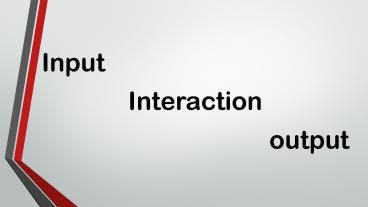INPUT, OUTPUT, INTERACTION - PowerPoint PPT Presentation
Title:
INPUT, OUTPUT, INTERACTION
Description:
Suzan Gass,2013 – PowerPoint PPT presentation
Number of Views:21
Title: INPUT, OUTPUT, INTERACTION
1
- Input
- Interaction
- output
2
Input
- Input what is available to the learner
- Intake what is actually internalized by the
learner - Baby talk, motherese, caretaker speech,
child-directed speech - Speech directed toward young children.
- Foreigner talk
- speech directed toward linguistically deficient
NNSs
3
- NNS How have increasing food costs changed your
eating habits? - NS Well, we dont eat as much beef as we used
to. We eat more chicken, and uh, pork, and uh,
fish, things like that. - NNS Pardon me?
- NS We dont eat as much beef as we used to. We
eat more chicken and uh, uh pork and fish. We
dont eat beef very often. We dont have steak
like we used to.
4
- NNS How have increasing food costs changed your
eating habits? - NS Well, I dont know that its changed THEM. I
try to adjust. - NNS Pardon me?
- NS I dont think its changed MY EATING HABITS.
5
- What factors determine comprehension?
- Grammaticality of someones speech, as well as
pronunciation and vocabulary. - Ones ability to understand.
- Indication of understanding
Backchannel cues - Use of words (yeah, really) or sounds (hmm, oh)
by listener when someone else is speaking.
6
- Comprehension is facilitated by three factors
- Familiarity with a particular NNS
- Familiarity with nonnative speech in general
- Familiarity with the discourse topic
7
Interaction
- The interaction approach accounts for learning
through input (exposure to language), production
of language (output), and feedback that comes as
a result of interaction. - Interaction involves a number of components,
including negotiation, recasts, and feedback.
8
- Negotiation of meaning refers to those instances
in conversation when participants need to
interrupt the flow of the conversation in order
for both parties to understand what the
conversation is about. - J NS of Japanese S NS of Spanish
- J And your what is your mm fathers job?
- S My father now is retire.
- J Retire?
- S Yes
- J oh yeah.
- ....
9
- Forms throughout conversations in which there is
a nonproficient NNS participant - Comprehension check
- NNS I was born in Nagasaki. Do you know
Nagasaki? - Confirmation check
- NNS1 When can you go to visit me?
- NNS2 Visit?
- Clarification request
- NNS1 . Research.
- NNS2 Research, I dont know the meaning.
10
output
- Input alone isnt sufficient for acquisition,
because, when one hears language, one can often
interpret the meaning without the use of syntax.
Production, then, may force the learner to move
from semantic processing to syntactic
processing. - In what ways can output play a central role in
the learning process? - Receiving crucial feedback for the verification
of these hypotheses. - Testing hypotheses about the structures and
meanings of the target language. - Developing automaticity in IL production.
- Forcing a shift from more meaning-based
processing of the L2 to a more syntactic mode.
11
- Feedback is an important source of information
for learners. It provides them with information
about the success of their utterances and gives
additional opportunities to focus on production
or comprehension. - Learner
- She eat a sandwich last night.
- Teacher
- Full repetition She eat a sandwich last night?
- Partial repetition Eat last night? Eat?
- Elicitation She what stressed last night?
- Metalinguistic information It happened last
night. So what should we say? (How do we form the
past in English?)
12
i
Interaction
Recasts
Negotiation
Learning
Feed back
Attention
13
Recasts
- A recast is a reformulation of an incorrect
utterance that maintain the original meaning of
the utterances. - They are less directed and implicit feed back.
- For Example
- NNS Why he want this house ?
- NS Why does he want this house?
14
Hypothesis Testing
- That is, the activity of using language helps
create a degree of analyticity that allows
learners to think about language. - This is not to say hypothesis are being
consciously tested every time an L2 speaker
produces an utterance. - For example
- 1Ah the dog is barking to
- 2At!
- 1At the woman
15
The Function of input and interaction
- Different Input
- 1.Positive evidence set of well formed
utterances to which learners are exposed - 2. Negative evidence consist of information
provided to a learner that his utterance is
deviant and it has two kinds Direct and Indirect
16
The Function of input and interaction
- For example
- NS Did you fly to Singapore yesterday?( Positive
evidence ) - NNS Did I flied here yesterday?
- NS Sorry
- NNS Did I flied here yesterday?
- NS Yes, did you fly here yesterday?( Indirect
Negative evidence )
17
Limitation of Negative evidence
- First, correction can not occur with all
incorrect forms - Second, many cases the learner may not even
realize that an error has occurred . - Third, it doesnt provide sufficiently specific
information to inform the learner where exactly
an error has been made
18
Example for second limitation
- NS When I get to Paris, Im going to sleep for
one whole day. Im so tired. - NNS What ?
- NS Im going to sleep for one whole day
- NNS One hour a day?
- NS Yes.
19
Function of interaction
- Conversational interaction contributes to
development of language, because it is the means
by which the learner is able to crack the code. - This take place when the learner can infer what
is said even though the massage contains
linguistic items that arent yet part of his
competence.































